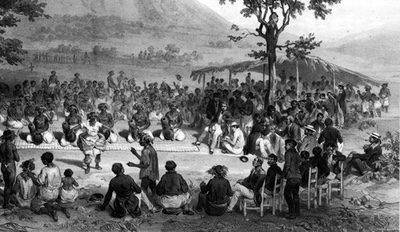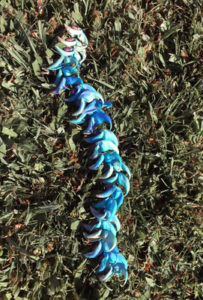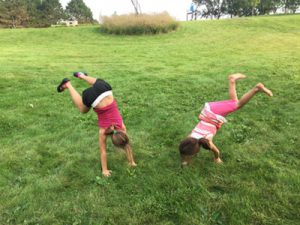 In 1778 British Naval Captain James Cook came upon a fascinating and beautiful place that he called the Sandwich Islands. The local people called it Hawaii. Soon after that, whalers, missionaries and explorers from the United States and Europe came to the islands and brought many of their cultural ways, including the ubiquitous use of chairs. The drawing above shows a luau honoring French sailors in 1836, just 58 years after the first documented contact that Hawaiians had with Europeans. It illustrates a profound yet commonly overlooked cultural difference: Chair sitting verses floor sitting.
In 1778 British Naval Captain James Cook came upon a fascinating and beautiful place that he called the Sandwich Islands. The local people called it Hawaii. Soon after that, whalers, missionaries and explorers from the United States and Europe came to the islands and brought many of their cultural ways, including the ubiquitous use of chairs. The drawing above shows a luau honoring French sailors in 1836, just 58 years after the first documented contact that Hawaiians had with Europeans. It illustrates a profound yet commonly overlooked cultural difference: Chair sitting verses floor sitting.
You’ll see in the picture that almost all the people in European dress are seated on chairs and all the people in Hawaiian clothing are sitting on the ground.
I cannot definitively say when the use of chairs became common practice in Hawaii but I am going to guess that most Hawaiians did not own chairs until the 19th century. They didn’t have to. Like many people around the world, traditional Hawaiians did much of their food preparation sitting and squatting. They also socialized while sitting on or close to the ground. They slept on mats that they wove from local trees. They simply didn’t need chairs.
As floor and earth sitters, Hawaiians got up and down the floor multiple times a day. Their natural movements resulted in the development and maintenance of an aligned and robust skeleton which supported a healthy level of agility, flexibility and muscular strength. The physical prowess needed for the deep knee bends and intricate hip movements of hula was a regular part of island life.
These cultural habits provided native Hawaiians with what bio-mechanist Katy Bowman terms Nutritious Movement. Along with advocating for whole-body movement, Bowman has written extensively about the deleterious effects of chair sitting. Her work shows how frequent chair sitting adversely affects the shape of ones bones, as well as the strength of one’s muscles. She convincingly claims that along with decreasing mobility and balance, our habits of chair sitting not only underlie much of the back and neck pain that is rampant today, but is at the root of many diseases related to digestion and pelvic health.
In the 1950s an anthropologist names Gordon W. Hewes estimated that ¼ of the world doesn’t sit in chairs but spends most of their time squatting. He documented the variety of ways that humans sit and stand. You can see a selection of those positions here.
With the advent of industrialization and technology, the percentage of people who don’t sit in chairs is now much smaller.
This makes me think of an analogy: Chairs are like white bread.
Here’s why:
Nutrient-dense whole grain bread was a European staple for centuries. As milling techniques advanced, bakers developed the ability to remove the bran and the germ so they could make bread that was lighter and whiter. Because the effort to do this was costly, white bread was only available to the wealthy and quickly became a status symbol. When white bread finally became more cost effective, it had the reputation for being desirable so everyone started eating it despite it being nutrient deficient. It is only recently that whole grains have become popular because they are now recognized for their nutritional value.* Perhaps more floor sitting is the next step.
Just as people are returning to whole grain bread, I advocate that we spend less time picking out furniture and more time hanging out on the floor. While this bold cultural shift is my ideal vision, I want to acknowledge that just as it takes time to change our taste preferences, it takes time for our bodies to adjust to new movements. Floor sitting may not be accessible to all and/or it may take time to develop but it is something that we can all work toward.
*My grandfather worked for over 40 years at a bakery that made hearty pumpernickel and rye bread. He would bring it home everyday. My aunt chuckles jovially when she reminisces about how silly it was that she used to yearn for soft and fluffy Wonder Bread.



I have wonderful memories about pumpernickel bread and my grandmother. She would give it to me slathered in unsalted butter (So what could be bad?) and a piece of matjes herring, which she had pickled herself, along side. I can see us sitting at her kitchen table like it was yesterday. I got white bread at home so I did not long for it. Hearty, whole grain bread is still one of my greatest pleasures!